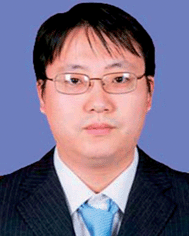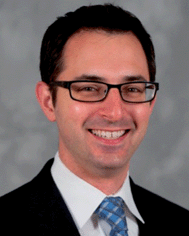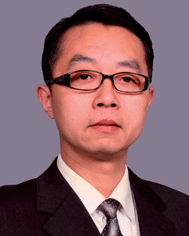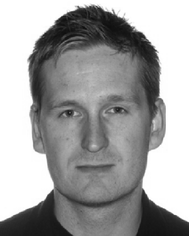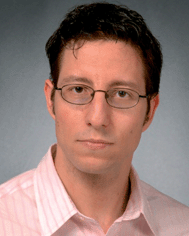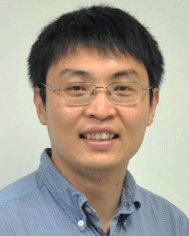DOI:
10.1039/C4TC90035A
(Profile)
J. Mater. Chem. C, 2014,
2, 3031-3046
Profile: Emerging Investigators
Aaron M. Massari is an Associate Professor of Chemistry at the University of Minnesota – Twin Cities. He received his B.S. in Chemistry from Arizona State University in 1999 and his PhD in Chemistry from Northwestern University in 2004. He was a NIH Ruth L. Kirschstein postdoctoral fellow at Stanford University before beginning his independent career at the University of Minnesota in 2006. His group's research efforts combine nonlinear spectroscopies, such as vibrational sum frequency generation and 2D-IR, with materials systems, with a particular emphasis on organic conducting and semiconducting thin films.
Dr Alison Funston is a lecturer and Future Fellow at the School of Chemistry at Monash University, Melbourne, Australia. Dr Funston received her PhD from the University of Melbourne, Australia, in 2002. After working as a postdoctoral fellow at Brookhaven National Laboratory with Dr John Miller in the areas of electron transfer and radiation chemistry, she returned to the University of Melbourne where she worked with Prof. Paul Mulvaney on the spectroscopy of nanoscale systems. She moved to Monash as a lecturer in 2010 and was awarded an ARC Future Fellowship in 2011. Her research focuses on the energy transport and optical properties of well-defined assemblies of nanoparticles, including metal nanocrystals and semiconductor nanocrystals, as well as charge and energy transfer within nanoparticle–organic systems.
Aram Amassian was appointed Assistant Professor of Materials Science and Engineering in 2009 at the King Abdullah University of Science and Technology (KAUST), in Thuwal, Saudi Arabia. Aram completed his PhD in Engineering Physics from Ecole Polytechnique de Montreal, Canada, in 2006, and was subsequently a postdoctoral fellow in the Malliaras group in Materials Science and Engineering at Cornell University (2006–2009). He was awarded the NSERC (Canada) Postdoctoral Fellowship, as well as the American Vacuum Society's Electronic Materials Postdoctoral Award. Since 2013, Aram has been the Career Development SABIC Chair for his work in solution processed optoelectronic materials. At KAUST, Aram has established the Organic Electronics and Photovoltaics Laboratory, which focuses on cutting edge research to enable the solution-based, scalable manufacturing of thin film-based organic electronic, optoelectronic and photovoltaic devices. He is the author of 55 publications in peer reviewed journals and has delivered nearly 30 invited talks at international conferences.
Dr Donna Arnold started her first full academic position at the University of Kent in 2010, having previously been a postdoctoral researcher at the University of St Andrews and University College Cork. Her research focuses on the search for novel multiferroics, technologically important materials which may form the basis of the next generation of electronics, such as memory devices. In addition, Dr Arnold is an active member of both the University and SPS Athena Swan committees, assessing and implementing best practices for women in science.
Jeffrey Mativetsky is an Assistant Professor in the Department of Physics at Binghamton University, where he leads the Organic Electronics and Solar Cell Laboratory. His research is focused on nanoscale structure–function relationships in organic electronic systems. He received his PhD in Physics from McGill University (2006), and is a recipient of the Japan Society for the Promotion of Science Summer Fellowship, held at Kyoto University (2006), the Marie Curie Fellowship, held at the Supramolecular Science and Engineering Institute in France (2007–2010), and the Camille and Henry Dreyfus Environmental Chemistry Fellowship, held at Princeton University (2010–2012).
Daeyeon Lee received his B.S. in Chemical Engineering from Seoul National University in 2001 and received his PhD in Chemical Engineering from MIT in 2007. After his postdoctoral fellowship at Harvard University, Daeyeon joined the University of Pennsylvania in 2009 and is currently Associate Professor of Chemical and Biomolecular Engineering. Daeyeon's research interests include the structure–property relationship of nanoparticle assemblies, interfacial behavior of Janus particles, and microfluidic fabrication of functional structures. Daeyeon has won numerous awards including the 2010 Victor K. LaMer Award, the NSF CAREER Award, the 2012 KIChE President Young Investigator Award, the 2013 3M Nontenured Faculty Award, and the 2013 AIChE NSEF Young Investigator Award.
Alejandro L. Briseno was born and raised in Los Angeles, California. He received his B.S. from California State University, Los Angeles. In 2006, he completed his Master's degree in Chemistry at UCLA with Professor Fred Wudl on the synthesis and characterization of small-molecule conductors. His PhD thesis on molecular crystals was supported by a Bell Labs-Lucent Technologies Fellowship under Professor Younan Xia at the University of Washington. He subsequently did a one-year postdoc at UC Berkeley with Professor Peidong Yang, where he focused on inorganic–organic hybrid nanowire solar cells. In 2009, he joined the Department of Polymer Science & Engineering at the University of Massachusetts Amherst, where his research is centered on the synthesis of organic and polymer semiconductors, interfacial crystallization, and fundamental charge transport in organic devices. Professor Briseno is the recipient of the 3M Nontenured Award, the Office of Naval Research Young Investigator Program Award, the UMass Faculty Exceptional Merit Award, and the Presidential Early Career Award for Scientists and Engineers.
Ryan C. Chiechi was born in Los Gatos, California, USA in 1978. He obtained his bachelors degree in Biochemistry in 2001 from the University of Oregon under Prof. Michael M. Haley. He earned his PhD in Chemistry in 2005 from the University of California Los Angeles under Prof. Fred Wudl. In 2006 he moved to Harvard University for his postdoctoral work under Prof. George M. Whitesides. Since 2009 he has been an Assistant Professor at the Stratingh Institute for Chemistry and the Zernike Institute for Advanced Materials at the University of Groningen. His research focuses on the design and synthesis of conjugated polymers, unconventional nanofabrication, and molecular electronics.
Christine Luscombe obtained her PhD from the University of Cambridge in 2005 and worked with Prof. J. M. J. Fréchet at UC Berkeley for her postdoctoral studies. She started her position as an Assistant Professor in the Materials Science and Engineering Department in 2006, and was promoted to Associate Professor in 2011. She was appointed Adjunct Professor for the Department of Chemistry in 2013. Her research area focuses on the synthesis of semiconducting polymers and their hybrid materials. In her free time, Christine enjoys rowing, hiking, and kickboxing.
Cyril Poriel obtained his PhD at the University of Rennes 1 in porphyrin chemistry (2003, under Dr G. Simonneaux), and also worked in the groups of Prof. K. M. Smith and Prof. M. G. H. Vicente at Louisiana State University (USA). After a postdoctoral spell in the group of Prof. C. J. Moody (Exeter, UK), working on the total synthesis of natural products, he was appointed as a CNRS researcher at the University of Rennes 1 (2005). He received his ‘Habilitation à Diriger les Recherches’ in 2013. He is interested in all varieties of chemical synthesis, with an emphasis on complex π-conjugated systems for various applications: organic electronics, metal–organic frameworks, catalysis, electrode modification, and so on. However, his main research interest is the design of highly complex π-conjugated molecular architectures for organic electronics, and especially for blue OLED applications. If efficient multifunctional materials for electronics is always the goal of his fundamental approach, the nature of the “molecular objects” is at the heart of his research. Indeed, the design of complex and original π-systems may lead to new and unexpected properties, which can be further used to open new avenues in electronics. Cyril Poriel is the author or co-author of 50 publications, and in 2009 he received a ‘Young Chemist Award’ (42nd IUPAC congress).
David Scanlon is a lecturer in Computational, Inorganic and Materials Chemistry at UCL and at Diamond Light Source. He obtained his PhD in Chemistry from Trinity College Dublin in 2011. He then moved to UCL to take up a Ramsay Fellowship, which he held until September 2013. His research is focused on the application and development of computational techniques for the design and characterisation of functional inorganic materials.
Eric Toberer is an Assistant Professor in the Physics Department at the Colorado School of Mines and a Scientist at the National Renewable Energy Laboratory. Before starting at CSM/NREL, Eric was a Beckman Postdoctoral Fellow at Caltech (2006–2011). His research concerns the interplay of structure and properties in crystalline compounds, with a particular focus on transport phenomena in photovoltaic and thermoelectric materials. Material co-design through integrated experimental and computational investigation has been a hallmark of these investigations; these efforts are increasingly utilizing high throughput computational and synthetic techniques.
Fei Huang received his B.S. degree in Chemistry from Peking University in 2000, and gained his PhD degree in Materials Science from the South China University of Technology in 2005 under the supervision of Prof. Yong Cao. After postdoctoral work at University of Washington with Prof. Alex K.-Y. Jen, he began his academic career in 2009 as a professor at the South China University of Technology. His main interests are in the fields of organic functional materials and devices for opto-electronics.
Filipe Almeida Paz holds a first degree in Analytical Chemistry from the University of Aveiro (Portugal), and a PhD in Chemistry from the University of Cambridge (UK). He returned to Aveiro in 2004 to take up the position of Auxiliary Researcher at the Associated Laboratory CICECO. His research interests are focused on chemical crystallography and on the design and preparation of novel functional metal–organic frameworks, which may find applications as photoluminescent or catalytic materials. His current research group is composed of three PhD students and three post-doctoral fellows, and it has been financed over the years by numerous MOF R&D projects.
Dr Michael A. Filler is an Assistant Professor in the School of Chemical & Biomolecular Engineering at the Georgia Institute of Technology. He received a doctorate from Stanford University and completed a postdoctoral appointment at the California Institute of Technology. Dr Filler's research program lies at the intersection of chemical engineering and materials science, focusing on the fabrication and characterization of nanoscale semiconductors for applications in electronics, photonics, and energy conversion. He applies chemically sensitive
in situ techniques, particularly infrared spectroscopy, to probe the interfacial chemistry underlying the synthesis of these materials, and leverages this insight to rationally advance their structural complexity and function.
Dr Daniel Gomez is an ARC Post-Doctoral Research Fellow at the Materials Science and Engineering division of CSIRO, and a Technology Fellow at the Melbourne Centre for Nanofabrication. He completed a PhD in Chemistry at the University of Melbourne, under the supervision of Laureate Prof. Paul Mulvaney in 2007, where he studied the optical properties of individual semiconductor nanocrystals. This work was then awarded the Chancellors Price for Excellence in the PhD Thesis in 2008. He worked as a postdoc in CSIRO with Dr Timothy Davis, where he studied the surface plasmon resonance of interacting nanoparticles. He is currently a staff member of CSIRO working on applied plasmonics.
Ferdinand Grozema (1973) studied chemistry at the University of Groningen and obtained his PhD degree from the Delft University of Technology. In 2007 he spent 8 months working as a visiting scholar at Northwestern University in Evanston, USA. Currently he is an Associate Professor at the Chemical Engineering Department of the Delft University of Technology. His research interests consist of theoretical and experimental studies of the properties and dynamics of excited states in bio/organic materials. In 2009 he was awarded an ERC Starting grant for this work.
Haifeng Yu received his PhD from Tsinghua University (2003). Then he went to Japan, where he worked as a researcher at JST-CREST, and then as a postdoc at JSPS at the Tokyo Institute of Technology and Kyodo University, respectively. In 2008, he started his independent research as Associate Professor by special appointment at the Nagaoka University of Technology. In 2012, he joined Peking University as a Research Professor, having received the honor of the 2011 National Thousand Young Talents Program. In 2013, he obtained a NSFC Award for Excellent Young Scholar. His research interests focus on photoresponsive soft matter, self-assembled materials, and organic–inorganic hybrid materials.
Brett A. Helms received his B.S. (2000) from Harvey Mudd College and his PhD (2006) with Jean M. J. Fréchet at the University of California, Berkeley in organic and macromolecular design and synthesis. He joined the staff of the Molecular Foundry in 2007, after postdoctoral research at the Technische Universiteit Eindhoven with E. W. (Bert) Meijer in understanding multivalent interactions in biological recognition and biomolecular targeting. His research interests include the synthesis, assembly and function of multicomponent materials with hierarchical structure, spanning the atomic-to-molecular as well as meso- to macroscale for applications in energy and biology.
Luis E. Hueso is currently an IKERBASQUE Research Professor and leader of the nanodevices groups at CIC nanoGUNE in San Sebastian (Spain). He obtained a PhD in Physics from Santiago de Compostela (Spain), and after postdoctoral experience in Cambridge (with Neil Mathur) and in Bologna (with Alek Dediu), he worked as a lecturer at the University of Leeds before taking up his current position in 2009. His research interests lie in the fields of spintronics with molecular materials, electronic memory devices, plasmonics and nanofabrication, topics in which he has published extensively. He is currently an ERC Starting Grant holder.
Jacek J. Jasieniak completed his PhD in Chemistry at the University of Melbourne in 2008 and was awarded the Chancellor's Prize for best thesis across science and engineering. He then joined the CSIRO as an OCE postdoctoral fellow to work on solution-processed solar cells. In 2011, he was awarded a Fulbright fellowship to work with Prof. Alan Heeger at the University of California Santa Barbara on organic electronics. He returned to CSIRO in 2012, where he is currently a senior research scientist and leads a team in the area of solution-processed inorganic electronics.
Jr-Hau He received the B.S. and PhD degrees from the National Tsing Hua University, Hsinchu, Taiwan, in 1999 and 2005, respectively. He is currently an Associate Professor at the Institute of Photonics and Optoelectronics and the Department of Electrical Engineering, National Taiwan University, Taipei, Taiwan. He is involved in the design of new nanostructured architectures for nanophotonics and the next generation of nanodevices, including photovoltaics and resistive memory. Prof. He is a recipient of the Outstanding Young Electrical Engineer Award from the Chinese Institute of Electrical Engineering (2013), the Outstanding Youth Award of the Taiwan Association for Coating and Thin Film Technology (2012), the Youth Optical Engineering Medal of the Taiwan Photonics Society (2011), the Distinguished Young Researcher Award of the Electronic Devices and Materials Association (2011), the Prof. Jiang Novel Materials Youth Prize of the International Union of Pure and Applied Chemistry (IUPAC) (2011), and the Exploration Research Award of the Pan Wen Yuan Foundation (2008). He was selected as a Member of the Global Young Academy (2011), and has won numerous awards and honors with his students in professional societies and conferences internationally. He actively participates in the activities and services of professional scientific societies.
Manuela Melucci is currently group leader of the Laboratory for the Synthesis of Functional Organic and Hybrid Materials, ISOF, at the Institute of the National Research Council of Italy of Bologna. Her current main research interests focus on: (i) the design and synthesis of advanced molecular semiconductors, (ii) the optimization of cleaner synthetic methodologies for the high yield/high purity preparation of organic materials, and (iii) the development of graphene-based composites, aimed at the application of organic electronics.
Mariano Campoy-Quiles' group is driven by the ambition to use scientific knowledge to enable access to clean energy using solar and heat energy conversion. With this aim in mind, his group focuses on understanding the fundamental properties and developing nanostructuration protocols in order to improve organic photovoltaic and thermoelectric performance. His work is highly recognized world-wide, as illustrated by the many citations his
ca. 50 publications have received, and the 2012 Young Researcher in Experimental Physics Award he was awarded by the Spanish Royal Society of Physics. He obtained his Physics degree from the University of Compostela, and his PhD from Imperial College London. After a fellowship at JAIST in Japan, he moved to ICMAB in 2008, where he currently holds a permanent tenured position.
Anne J. McNeil is an Associate Professor of Chemistry and Macromolecular Science and Engineering at the University of Michigan, Ann Arbor. Her research focuses on the relationship between (macro)molecular structure and properties in new organic materials. She has garnered several research and teaching awards, including a Camille and Henry Dreyfus Teacher-Scholar Award, an Alfred P. Sloan Research Fellowship, a Presidential Early Career Award for Scientists and Engineers, and the Arnold and Mabel Beckman Young Investigator Award. She enjoys spending her “free” time playing with her son (Evan) and husband (Matthew), and is looking forward to the new bundle of joy joining her family in May 2014.
Tyrel M. McQueen received his B.S. in Chemistry from Harvey Mudd College, and a PhD in Chemistry and Materials from Princeton University. He was hired as an Assistant Professor in Chemistry, Physics and Astronomy at Johns Hopkins University in 2009, and took a one year leave of absence for postdoctoral studies at the Massachusetts Institute of Technology. The McQueen laboratory is focused on the design, discovery, and synthesis of materials with exotic electronic states that have applications ranging from energy to fundamental science. Particular emphasis is placed on experimentally determining how simple, local interactions give rise to a plethora of emergent phenomena. Synthetically, we have been expanding the reaction scope of ‘soft chemistry’ methods for the preparation of new meta- or kinetically-stable solids. Analytically, we have been developing modern pair distribution function analysis techniques that leverage computing advances to determine local structure and dynamics. Together, these new tools are allowing us to elucidate how emergent phenomena, such as superconductivity, arise from local interactions of charge, orbital, and spin degrees of freedom. More generally, these techniques are for the first time allowing us to rationally design new materials with improved properties,
i.e. true materials by design.
Tsuyoshi Michinobu, born in Hiroshima (1976), received his B.E. (1999), M.E. (2000), and PhD degrees (2003) in Applied Chemistry from Waseda University. After working as a Postdoctoral Fellow at ETH Zurich and the National Institute for Materials Science (NIMS), he started his academic career at Tokyo University of Agriculture and Technology as Research Associate in 2006. He moved to Tokyo Institute of Technology as an Assistant Professor in 2008, and was promoted to Associate Professor in 2012. His research interests are in the area of conjugated molecules and polymers with particular focus on energy storage and conversion applications.
Kasper Moth-Poulsen received his B.Sc, Cand. Scient. and PhD degrees in Chemistry from the University of Copenhagen (Denmark). He was a postdoctoral fellow at the University of Copenhagen (with Prof. Bjørnholm) and then at University of California at Berkeley (with Prof. Segalman and Prof. Vollhardt). He currently holds the position of Assistant Professor at Chalmers University of Technology (Sweden). His research is focused on synthetic chemistry, single molecule electronics, nanoparticle synthesis, energy storage and self-assembly.
Oana Jurchescu is an Assistant Professor of Physics at Wake Forest University. She received her PhD in 2006 from the University of Groningen, and was a postdoctoral researcher at the National Institute of Standards and Technology. She has won a National Science Foundation CAREER award, the Reid-Doyle Prize for Excellence in Teaching, and the Ralph E. Powe Junior Faculty Enhancement award. Her expertise is in the structure and properties of organic semiconductors. She is an associate editor of the Journal of Electronic Materials, and a program committee member for the Electronic Materials Conference, Device Research Conference and the International Semiconductor Device Research Symposium.
Pavle Radovanovic is an Associate Professor of Chemistry and a Canada Research Chair in Spectroscopy of Nanoscale Materials at the University of Waterloo. He obtained his Dipl. Chem. degree (B.S. equivalent) from the University of Novi Sad (Serbia), his M.S. degree from Georgetown University, and a PhD degree from the University of Washington (Seattle), all in Chemistry. After postdoctoral research at Harvard University, he joined the University of Waterloo as an Assistant Professor in September 2006, and was promoted to an Associate Professor with tenure in July 2012. At Waterloo he embarked on a new research program in the area of solid state physical-inorganic chemistry focusing on the design, synthesis and fundamental physical and chemical properties of multifunctional low-dimensional materials. His research interests include polymorphism and phase transformation at the nanoscale, nanostructure doping and functionalization, semiconductor nanospintronics and quantum information processing, nanophotonics, light emitting nanomaterials and devices, and photocatalysis. This work has been recognized by national and international awards, including the Canada Research Chair (NSERC), the Early Researcher Award (Ontario Ministry of Research and Innovation), and the Invitation to France Mobility Award (French Ministry of Foreign Affairs).
PingAn Hu received his PhD in Physical Chemistry from the Institute of Chemistry, Chinese Academy of Science in 2004. He worked at Waseda University in Japan as a JSPS postdoctoral fellow during 2004–2006. He then moved to the Engineering Department at the University of Cambridge as a Research Associate for three years. He is currently a Professor at the Centre for Nano/Microtechnology, Harbin Institute of Technology, China. His current research interests focus on the preparation, properties, electronics and optoelectronics of 2D materials.
Satish A. Patil received his Master's degree in Organic Chemistry from Dr Babasaheb Ambedkar Marathawada University in 1998. He conducted doctoral research in Organic Chemistry/Polymer Science under the guidance of Prof. Ullrich Scherf at Bergische University of Wuppertal, Germany. In 2004, he joined Prof. Fred Wudl's research group as a postdoctoral fellow at California Nano Systems Institute (CNSI) at the University of California, Los Angeles. After a three year postdoctoral stay at Prof. Wudl's research group, he joined the Solid State and Structural Chemistry Unit (SSCU), Indian Institute of Science, Bangalore, India as an Assistant Professor in June 2006. Currently he is working as an Associate Professor and his research work is focused towards the design and synthesis of novel multi-functional macromolecules for varied applications in organic electronics and drug delivery systems. He is a recipient of the INSA Young Scientist Award (2009), a Young Associate for the Indian Academy of Sciences (2009–12), the World Academy of Sciences Young Affiliate (2013–2017), and the Microsoft Research India Outstanding Young Faculty Award for the year 2011.
Jessica Rodríguez-Fernández, born in 1981 in Spain, studied Chemistry at the University of Vigo (Spain), where she graduated with Honours in 2004 and obtained her PhD in 2008. She carried out her PhD in the Colloidal Chemistry Group of Prof. Luis M. Liz-Marzán as a fellow of the Spanish Ministry of Science (FPU fellow). During her PhD she gained insight into the fields of colloidal chemistry and plasmonics, through PhD work that focused on the synthesis, reactivity and optical studies of gold nanoparticles of various shapes. Furthermore, during her PhD she also worked as a visiting researcher on far-field single particle spectroscopy in the group of Prof. Paul Mulvaney (University of Melbourne, Australia), and on dynamic light scattering investigations in the Soft Condensed Matter Group of Prof. Jan K. Dhont (Jülich Forschungszentrum, Germany). Upon completion of her PhD at the end of 2008 she joined the Photonics and Optoelectronics Group of Prof. Jochen Feldmann at the Ludwig-Maximilians-University (LMU) in Munich (Germany) as a postdoctoral researcher, where she has headed the Chemistry laboratory since 2009. In 2011 she accepted a group leader position at the chair, and since then she has led the “Functional Nanoparticles & Nanostructures” group (http://www.phog.physik.uni-muenchen.de/). Her research interests span from functional nanoparticles to hybrid nanocomposites, nanostructures and functional assemblies with appealing optical properties for applications ranging from optics, to photoenergy conversion and biology. She is the principal investigator of projects funded by the 7th Framework Programme of the European Union (http://www.fp7-union.eu/), the German Federal Ministry of Economics and Technology, and the Junior Research Fund (within the DFG's Excellence Initiative, LMUexcellent).
Shuhei Furukawa is an Associate Professor at the Institute for Integrated Cell-Material Sciences (WPI-iCeMS), Kyoto University, Japan. He received a PhD in 2005 from Kyoto University under the supervision of Susumu Kitagawa. He subsequently joined the group of Steven De Feyter at the Katholieke Universiteit Leuven, Belgium, as a postdoc to work on molecular self-assembly at solid–liquid interfaces. In 2007 he came back to Kyoto University as an Assistant Professor and started his research on metal–organic frameworks. After working in the ERATO Kitagawa Integrated Pores Project as a group leader (2008–2010), he was appointed Associate Professor at WPI-iCeMS, Kyoto University in 2010. His current research interests focus on the structuring of metal–organic frameworks at the mesoscale and their applications in electronics and cell biology.
Michael Sommer finished his PhD thesis in 2009 on semiconducting block copolymers for organic electronic devices under the supervision of Mukundan Thelakkat at the University of Bayreuth, Germany. In 2010 he joined the group of Wilhelm Huck at the Department of Chemistry, University of Cambridge, UK, as a postdoctoral researcher. Since the beginning of 2012 he has been building an independent research group at the Albert-Ludwigs-University of Freiburg, Germany. His research interests encompass the synthesis of conjugated materials, controlled polymerisation methods, self-assembly and structure–function relationships of electronically active materials, and stimuli-responsive polymers.
Subi Jacob George received his PhD degree from the National Institute for Interdisciplinary Science and Technology, India, in 2005 under the supervision of Dr A. Ajayaghosh. From 2005 until 2008, he had a postdoctoral stay at the Laboratory of Macromolecular and Organic Chemistry, Eindhoven University of Technology, the Netherlands, under Prof. Dr E. W. (Bert) Meijer and Dr Albert Schenning. Here his major impetus was on understanding concepts in supramolecular chirality. He is currently an Assistant Professor at the New Chemistry Unit of JNCASR, Bangalore, India. His research interests focus on Functional organic and hybrid materials using molecular self-assembly.
Sudip Malik, born in Paschim Medinipur, West Bengal, India, completed a B.Sc. degree at the Ramakrishna Mission Vidyamandira (Belur Math), University of Calcutta, Kolkata, India in 1996, and an M.Sc. from the same university in 1998. He received his PhD degree (2003) from the Indian Association for the Cultivation of Science (IACS), Kolkata, with a thesis on the crystallization and gelation behaviour of poly(3-alkyl thiophenes), carried out under the supervision of Prof. A. K. Nandi. After finishing his PhD, he moved to the group of Prof. J.-M. Guenet at the Institut Charles Sadron, France, to study the synthesis of polymer materials with multiscale porosity (particularly from syndiotactic polystyrene (sPS)/solvent complexes). He then joined the group of Prof. S. Shinkai at Kyushu University, Japan as a JSPS researcher (2005–2007). In January 2008, he became an Assistant Professor at the Polymer Science Unit, IACS. On leave from IACS (2009–2011), he moved to the University of Nijmegen, the Netherlands as a Marie Curie Fellow (international category) to work with Prof. Alan E. Rowan. Currently, he is an Associate Professor at PSU, IACS. His current research interests are conducting polymers, electroluminescent polymers, small molecular hydrogels (perylene), sensors and hybrid materials for electronics and optoelectronic devices. He is also a recipient of a Young Associate of the Indian Academy of Science, Bangalore, India.
Tina T. Salguero is an inorganic and materials chemist and Assistant Professor. Since arriving at the University of Georgia (Athens, GA) in 2010, she has established a research program based on freestanding, two-dimensional inorganic nanomaterials. In her previous position at HRL Laboratories, LLC (Malibu, CA), she focused on energy technologies for commercial and military applications. She was educated at Columbia University (B.A.) and then the California Institute of Technology (PhD), working with Professor Robert Grubbs as a U.S. Department of Defense National Defense Science and Engineering Graduate Fellow. She conducted postdoctoral research with Professor Galen Stucky at the University of California, Santa Barbara, as a Damon Runyon Cancer Research Foundation Fellow. Her accomplishments include a recent U.S. Department of Energy Early Career Award for the synthesis and applications of complex metal oxide nanosheets.
Vincenzo Palermo is leader of the Functional Organic Materials unit of the National Research Council of Italy (CNR). He works on the production and nanoscale characterization of new materials using organic semiconductors and graphene. He is member of the scientific committee of EUROGRAPHENE and WP leader of the GRAPHENE FLAGSHIP, the largest strategic research initiative launched by the European Union in 2013. He has been the coordinator of the project of the European Science Foundation GOSPEL and of the International Training Network GENIUS. He has won the Lecturer Award for Excellence of the Federation of European Materials Societies in 2012, and the Research Award of the Italian Society of Chemistry (SCI) in 2013.
Vanessa Wood is an assistant professor in the Department of Information Technology and Electrical Engineering at ETH Zürich, where she heads the Laboratory for Nanoelectronics. In 2010, she received her PhD in Electrical Engineering from MIT, in which she worked on the development of quantum dot LEDs. Prior to joining ETH, she was a postdoctoral researcher in the Department of Materials Science and Engineering at MIT, working on novel lithium-ion flow batteries. In 2012, she was a recipient of an Intel Early Career Faculty Honor Award.
Xike Gao received his PhD degree in Chemistry from Institute of Chemistry, Chinese Academy of Sciences (CAS) in 2008, where he studied tetrathiafulvalene (TTF)-based organic semiconducting materials with Prof. Daoben Zhu and Prof. Yunqi Liu. Dr Gao joined the faculty team of Shanghai Institute of Organic Chemistry (SIOC), CAS in October 2008. Presently, he is an Associate Professor of SIOC. His research interests include the molecular design and synthesis of π-functional materials and their applications in organic electronics.
Yong Sheng Zhao received his PhD degree in 2006 at the Institute of Chemistry, Chinese Academy of Sciences (ICCAS). After that, he joined the University of California at Los Angeles (UCLA) and Northwestern University as a postdoctoral fellow. In 2009, he returned to ICCAS as a Professor of Chemistry. His research interests are focused on organic nanophotonic materials and devices, including the controllable synthesis of low dimensional organic materials, comprehensive investigation of the photophysical and photochemical processes involved in the materials, and the design, fabrication and performance optimization of photonic/optoelectronic nanodevices.
Zhenguo Chi received his B.S. degree in Chemistry (1991) from Hangzhou University (China), and his M. S. in Chemistry and Physics of Polymers (1994) from the Changchun Institute of Applied Chemistry, at the Chinese Science Academy. He obtained a PhD in 2003 from Sun Yat-sen University (China). From 2003 to 2006, he carried out his postdoctoral work at Fudan University (China) and Korea University (South Korea). He is currently a Professor of Physics and Chemistry of Materials at SYSU. His research is mainly on the development of organic and polymeric photoelectric materials.
Iwan Moreels obtained his PhD at Ghent University (Belgium) in 2009. After a stay at the IBM Zurich Research Lab (Switzerland), he move to the Italian Institute of Technology in 2012. Since then, he has led the Nanophotonics Lab at IIT. Fluorescent colloidal nanocrystals are at the center of his research, with topics ranging from materials synthesis to optical spectroscopy and photonic applications. For this paper, he worked together with several other young investigators to unravel the optical properties and carrier dynamics of wurtzite giant-shell CdSe/CdS quantum dots.
Prof. Joshua Goldberger received his PhD in Chemistry from the University of California at Berkeley with Professor Peidong Yang in 2006, as an NSF graduate fellow. He then did his postdoctoral research with Professor Sam Stupp at Northwestern University, as an NIH-NRSA postdoctoral fellow. He has received many awards, including an MRS Graduate Student Finalist Award in 2003, and an IUPAC Prize for Young Chemists in 2007. He joined the Ohio State University Chemistry and Biochemistry department as an Assistant Professor in 2010. His research focuses on the synthesis, properties and applications of single atom or polyhedron thick dimension-reduced materials.
|
| This journal is © The Royal Society of Chemistry 2014 |
Click here to see how this site uses Cookies. View our privacy policy here. 












